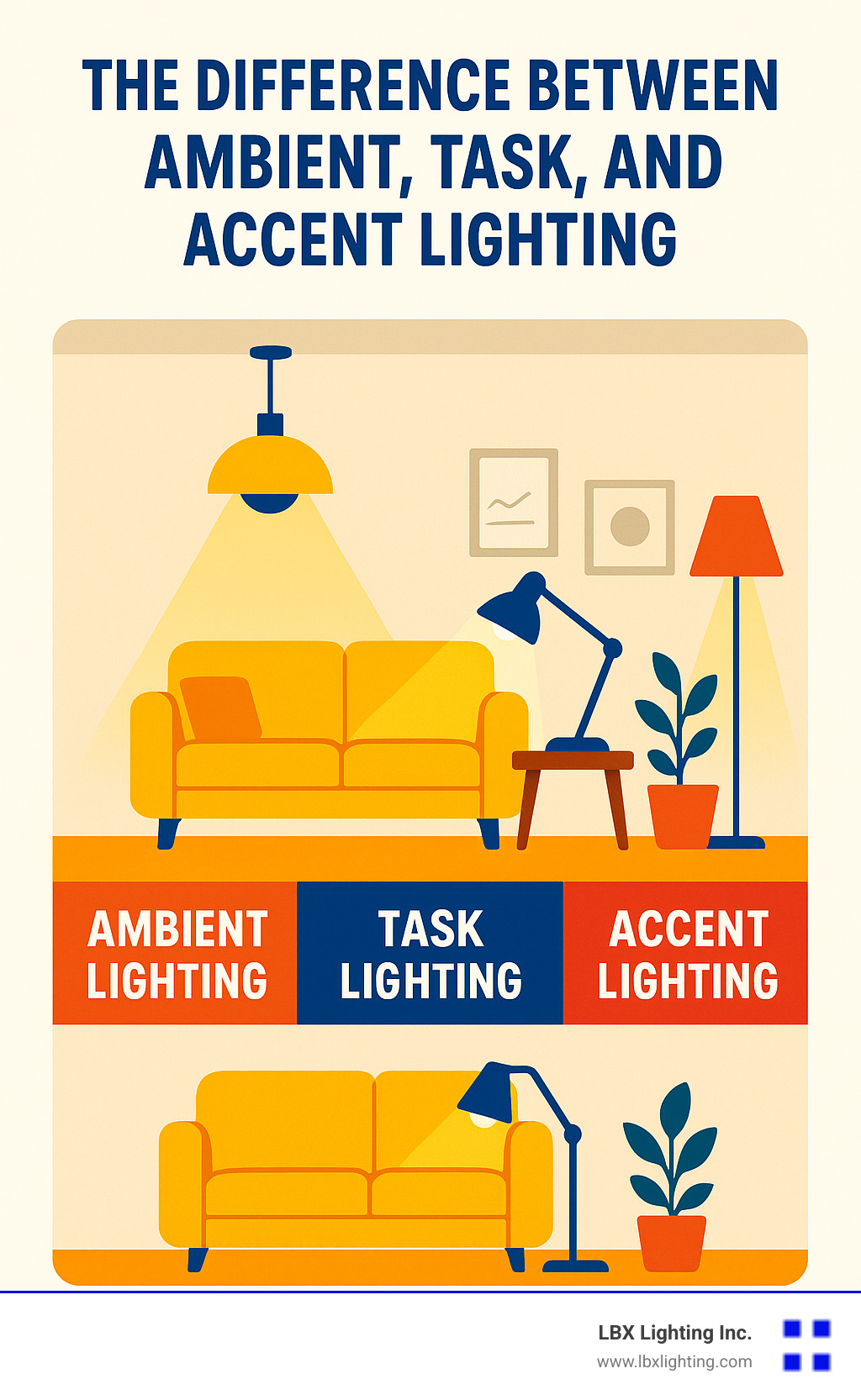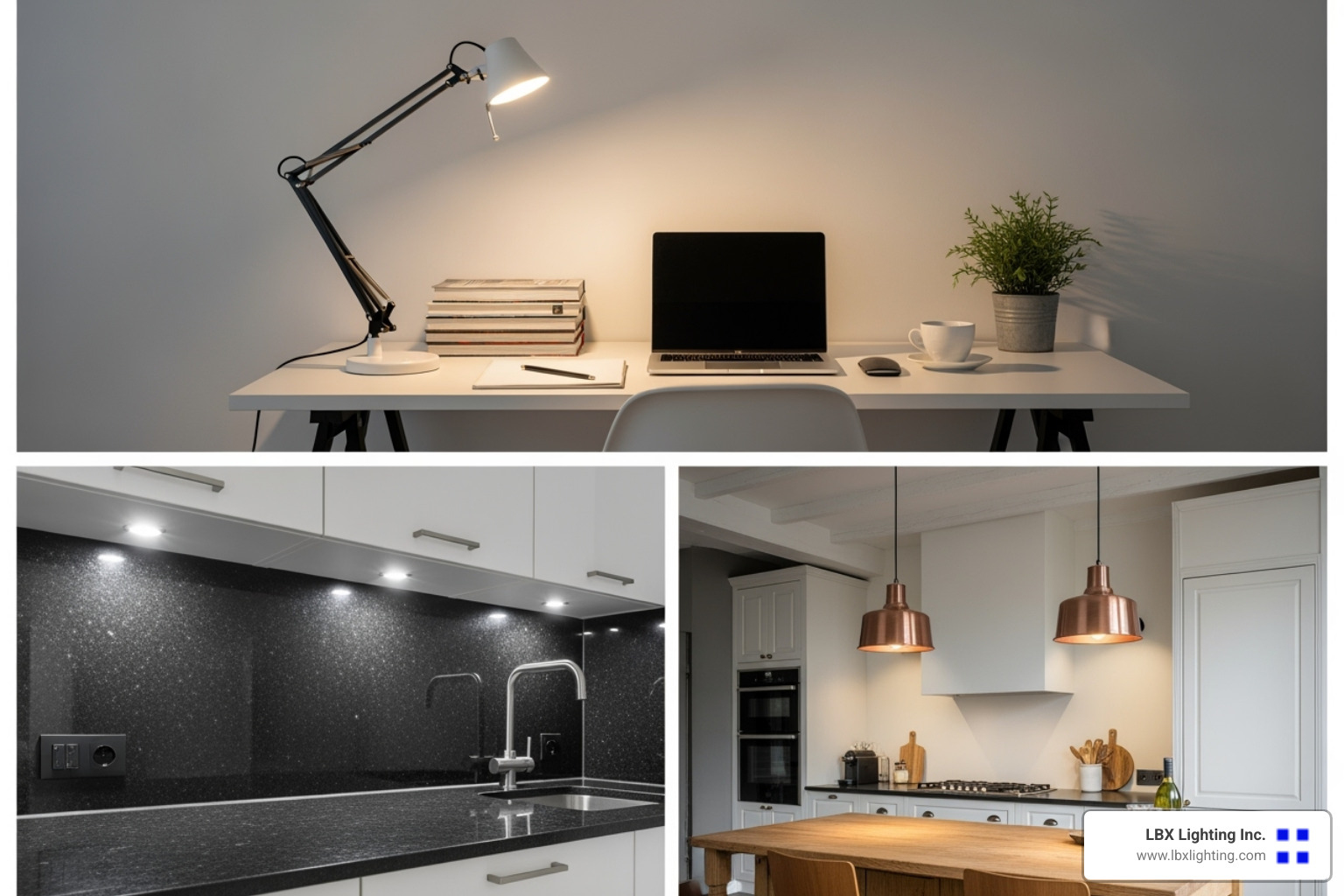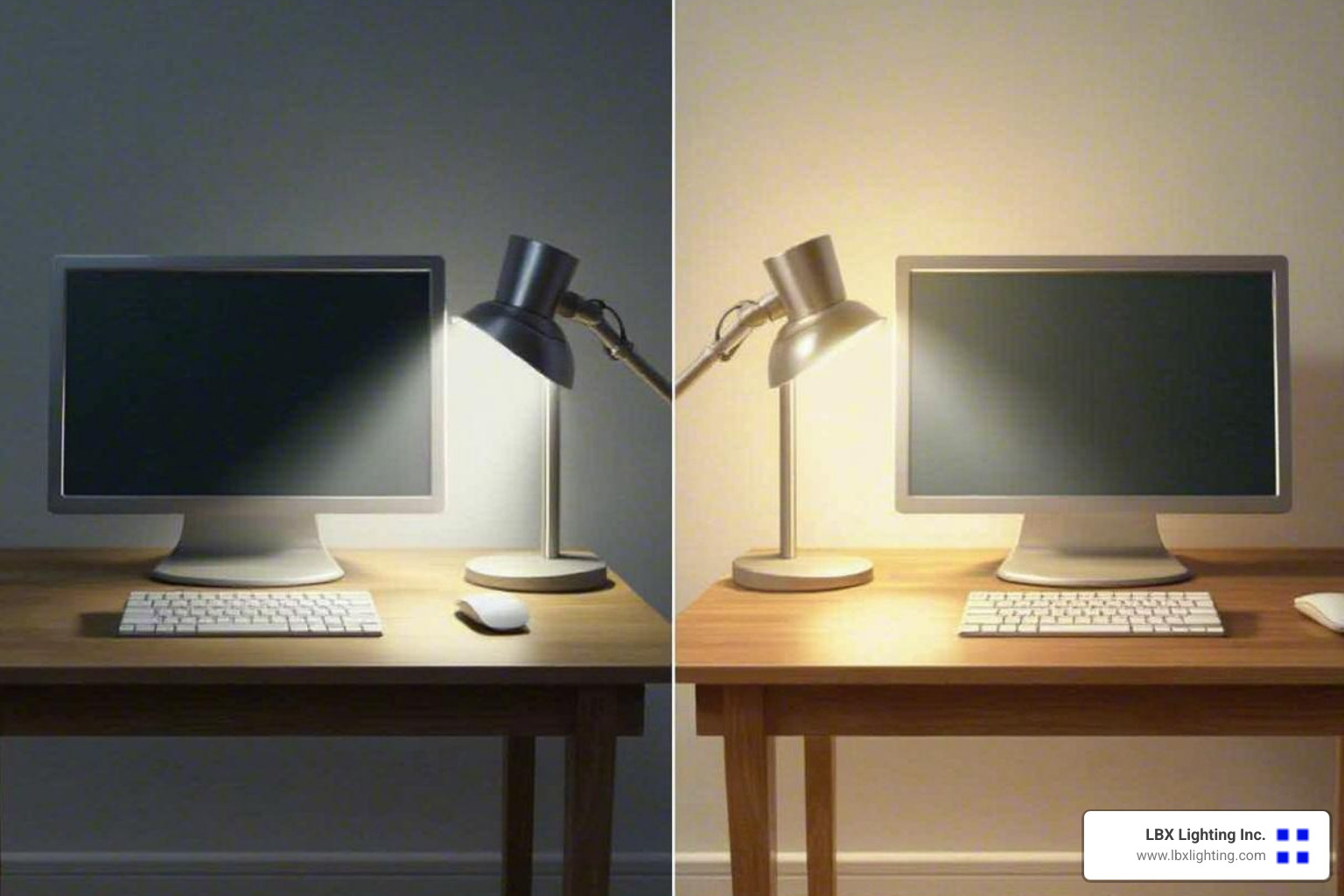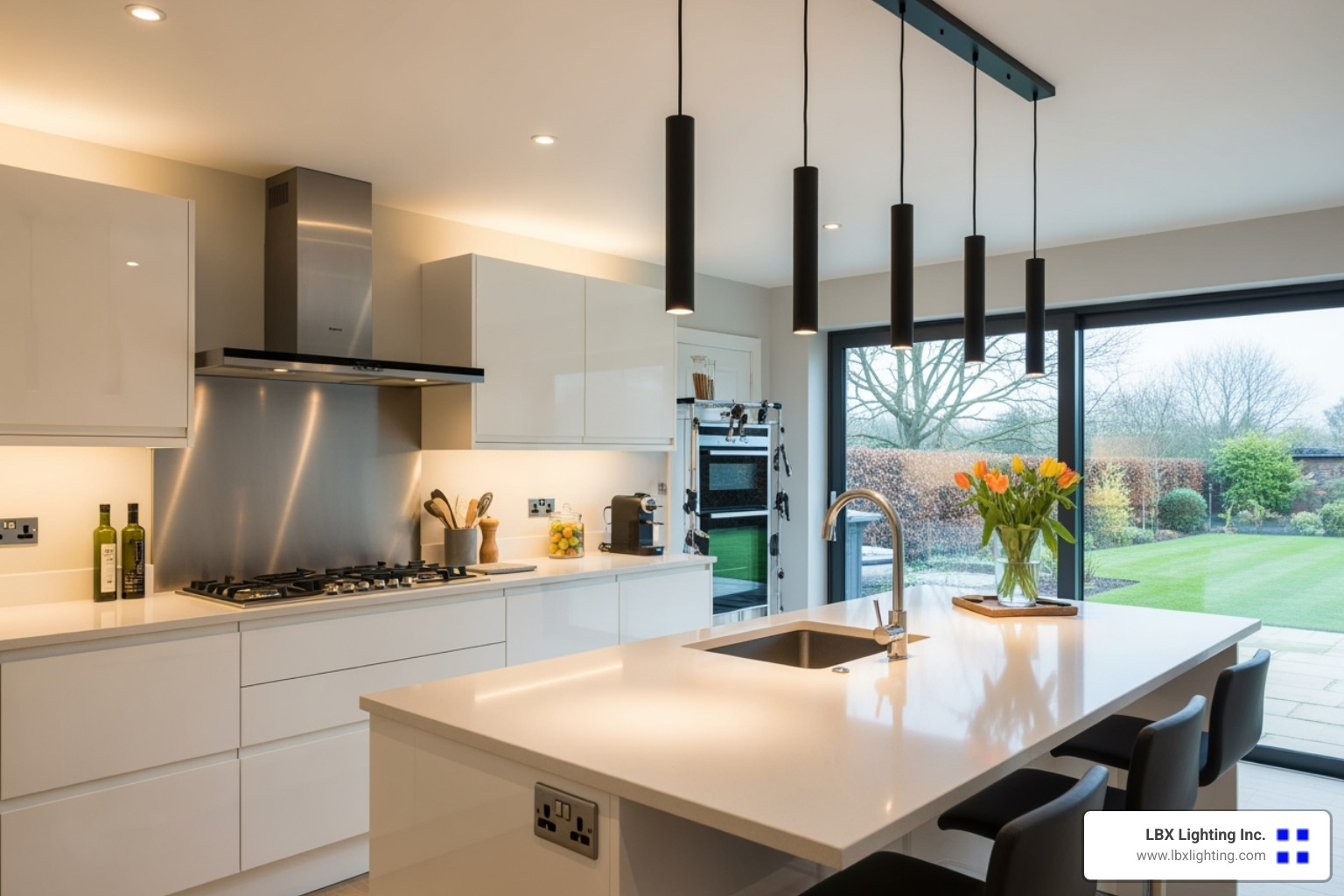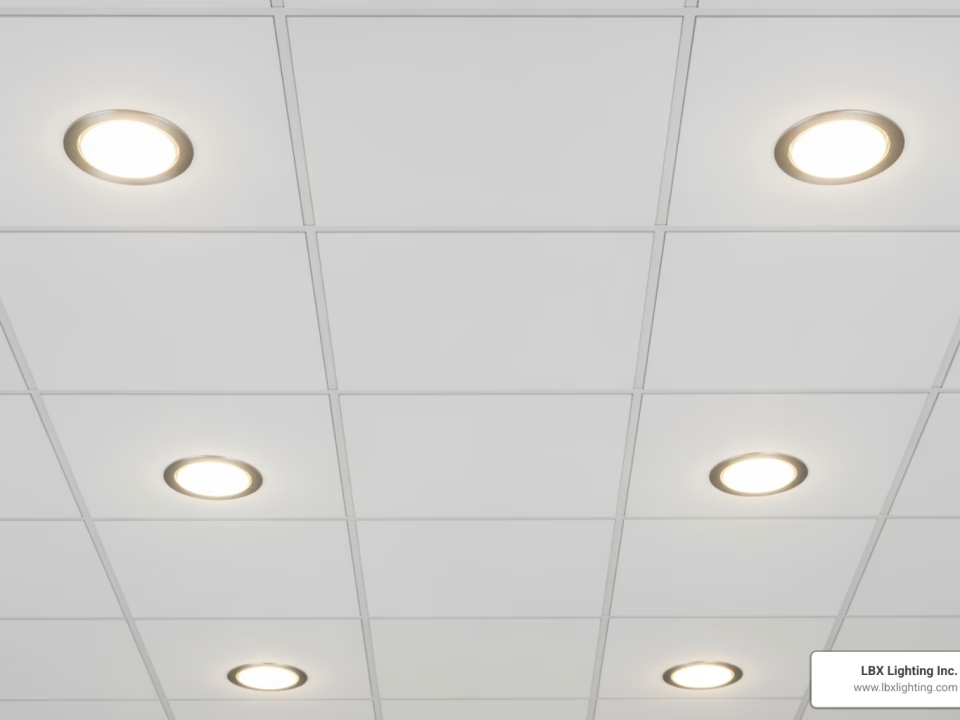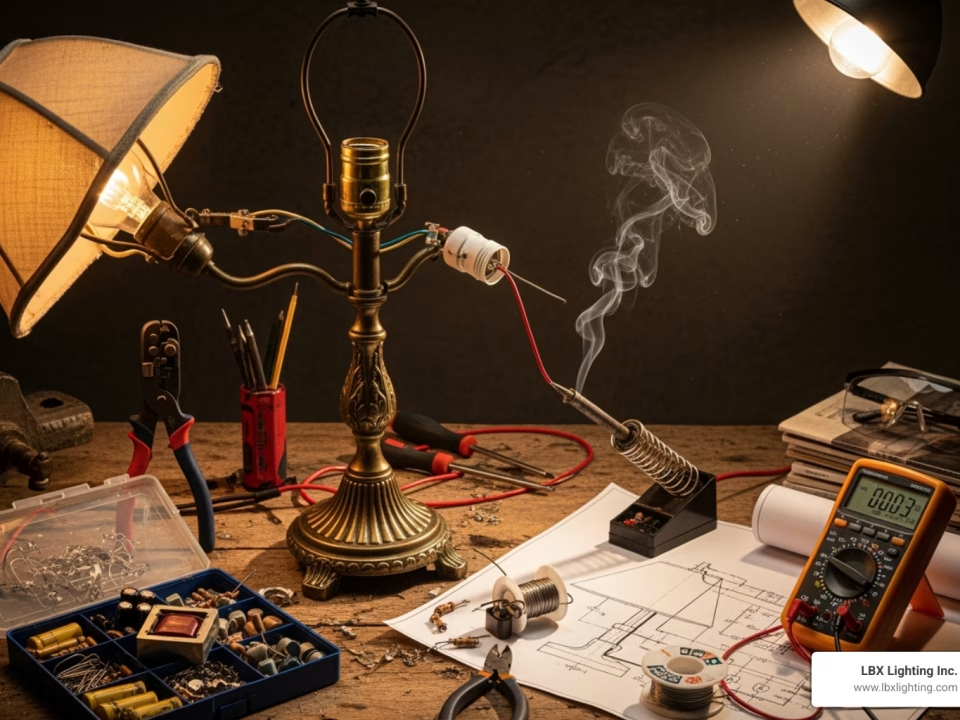
Shedding Light on Houston’s Premier Outdoor Lighting Companies
July 8, 2025
Commercial Track Lighting Solutions That Shine Brightest
July 15, 2025Beyond the Bulb – The Power of Purposeful Light
When it comes to your home, effective task light placement is crucial. It directly impacts your comfort and productivity. But what exactly does that mean?
Here are key guidelines for optimal task light placement:
- For Studying: Position your lamp about 15 inches from your work, on the opposite side of your dominant hand. Aim for about 450 lumens.
- For Reading: Place the light around 20 inches behind you, at a 30-degree angle to the side of your reading area. Use about 400 lumens.
- For Computer Use: Angle your desk lamp at 45 degrees, about 20 inches to the side or behind your monitor. This helps reduce glare.
- For Vanity Mirrors (side-mounted): Fixtures typically hang 60-70 inches from the ground, at eye level for even illumination.
- For Kitchen Countertops: Lumens needed can be as high as 7,000-8,000 for effective work. Lights often go between upper cabinets and the counter’s front edge.
- For General Alertness: Consider artificial lighting that mimics sunlight (between 5000K-7000K).
Task lighting provides concentrated light for specific activities like reading, cooking, or working. It’s different from ambient lighting, which offers general illumination for a whole room, or accent lighting, which highlights specific features.
Think of it as having distinct layers of light. First, a comfortable base of ambient light. Then, precise task lighting where you need it most. This layered approach helps reduce eye strain, increases your productivity, and even improves safety in your home.
Want to learn more about these layers? Check out our guide on Know the Three Types of Home Lighting.
Michael Eftekhar has proudly served Houston for over 30 years, offering an extensive inventory of lighting fixtures, chandeliers, and light bulbs. At LBX Lighting, we’re your ultimate destination for all your lighting needs, especially when it comes to mastering task light placement for both residential and commercial spaces.
Choosing Your Tools: A Guide to Task Lighting Fixtures
Think of task lighting as your personal spotlight for life’s little projects! Selecting the right light fixture is just like choosing the perfect tool for any job around the house. It needs to fit the task at hand, of course, but it should also look great and blend seamlessly with your home’s unique style. Here at LBX Lighting, we truly believe that fantastic function and beautiful design can, and absolutely should, go hand-in-hand. When we talk about effective task light placement, picking the right fixture is half the fun!
From portable desk lamps you can move anywhere to sleek, built-in under-cabinet lighting, each type of fixture brings its own special advantages for different tasks and spaces. Let’s explore the wonderful world of task lighting options and find how they can truly brighten your day (and your home!). For even more general advice, be sure to check out our helpful Lighting Tips.
Desk and Floor Lamps
These are probably the first things you think of when someone mentions a “lamp,” and for good reason! Desk and floor lamps are incredibly common and super versatile task lighting fixtures. Their best trick? They’re portable, meaning you can easily move them wherever you need a little extra light. This makes them true champions of flexibility!
Desk lamps, especially those with swing arms, are fantastic because they let you direct a focused beam of light exactly where you need it on your workspace. This adjustability is key for things like reading a book, writing notes, or working comfortably on your computer. For example, a good desk lamp usually sits about 15 to 20 inches above the desk surface. This height helps make sure your light is even and doesn’t cause any annoying glare.
Floor lamps, often with adjustable heads, do a similar job for reading nooks or craft areas. They deliver plenty of light right where you need it, whether you’re curled up with a novel or tackling a detailed hobby project.
Under-Cabinet and Strip Lights
Ever try to chop veggies in the kitchen, only to find your own shadow blocking the light from the ceiling? It’s a common problem! That’s exactly where under-cabinet and strip lights truly shine! These clever fixtures are designed for seamless integration. They mount right beneath your upper cabinets or shelves, sending light directly onto your work surface.
This means shadow-free illumination for your kitchen countertops, workshop benches, or even display areas. Think of the difference it makes when you can clearly see what you’re doing! LED strip lights, often about 1 to 2 meters long and providing anywhere from 300 to 600 lumens, are especially effective here. They’re super slim and energy-efficient, making those detailed tasks much easier and safer. Ready to make your home even smarter? Our Smart Home Lighting guide can show you how to integrate these seamlessly into your home’s tech.
Pendant Lights
While often thought of as beautiful decorative pieces, pendant lights are also incredibly effective task lighting fixtures when they’re placed just right. They’re designed to send light downwards, making them perfect for specific work surfaces. Imagine a bright, focused glow over your kitchen island, a craft table where you’re building a masterpiece, or even your dining table where you might spread out a project or do homework.
When considering task light placement for kitchen islands, a helpful rule of thumb is to space your pendants approximately 30 inches apart. This helps ensure you get lovely, even illumination across the whole surface. Not only do they provide excellent task lighting, but they also add a stylish, focused touch that truly ties a room together. Want to see more possibilities? Explore our full range of Pendant Light Fixtures.
Track and Recessed Lighting
If you love a clean, modern look and plenty of flexibility, then track and recessed lighting might be just what you need! Track lighting lets you position and aim multiple light heads along a track. This makes it super easy to highlight specific work surfaces or even beautiful wall art.
Recessed lighting, sometimes called “can lights,” are installed flush with your ceiling, giving you a smooth, uncluttered look. While they’re often used for general ambient light, you can strategically place them to work wonders as task lights too. For instance, recessed lights over a kitchen countertop should be located between the face of your upper cabinets and the front edge of the countertop below. This ensures the best possible illumination for your cooking tasks.
For basic downlights, a general rule of thumb is to place them 36 to 48 inches from the wall. If you have 8-foot ceilings, you’ll typically space them 2 to 4 feet apart. And for those special accent tasks, an optimal aiming angle of 30 degrees from the ceiling can help minimize glare. Ready to dive deeper into these versatile options? Check out our In-Depth Guide to Finding the Best Track Lighting and learn all about Recessed Canned Lighting.
Wall Sconces
Running low on floor or table space? Wall sconces are your secret weapon for clever task lighting! Their space-saving design makes them absolutely perfect for things like bedside reading. You get focused light right where you need it without cluttering up your nightstand. For bedside sconces, the top of the fixture should generally be between 55 to 60 inches from the floor, or about 30 to 36 inches from the top of your mattress, and no more than a foot from your bed frame.
They’re also great for lighting up specific task areas in hallways or as excellent vanity lighting in bathrooms. When used for a vanity, placing them about 60 to 70 inches from the ground at eye level helps provide even, flattering light for your face. Wall sconces do a wonderful job of creating a cozy, inviting atmosphere while still delivering all the functional light you need.
The Science of Sight: Key Factors for Optimal Placement
Understanding the “why” behind task light placement is just as important as knowing the “how.” It’s about more than just illuminating a space; it’s about optimizing your visual environment for comfort, efficiency, and long-term eye health. We dig into the ergonomics of light, ensuring your lighting setup supports your well-being.
Poor lighting can lead to eye strain, headaches, and even neck and back pain from subconscious postural adjustments. By applying a few scientific principles, we can create a comfortable and productive environment that feels effortless.
Banishing Shadows: The Golden Rule of Positioning
The most fundamental rule of task light placement is to ensure the light source effectively eliminates shadows cast by your body or hands onto your work. The key? Position the lamp on the side opposite your dominant hand. If you’re right-handed, place the lamp to your left; if you’re left-handed, place it to your right. This ensures that when you’re writing or performing a task, your hand doesn’t create a shadow directly over your work. The light should always come from in front of you, or slightly to the side, shining directly onto the workspace, rather than from behind. This simple adjustment makes a world of difference in visibility and comfort.
Conquering Glare: Protecting Your Eyes and Your Screen
Glare is the archenemy of good lighting. It can come in two forms: direct glare (from a light source shining directly into your eyes) and indirect glare (light reflecting off shiny surfaces, like your computer screen). Both cause eye strain and discomfort. To combat this, choose fixtures with diffusers or frosted bulbs that soften the light. For computer screens, positioning your desk lamp at a 45-degree angle and about 20 inches to the side or behind your monitor is highly effective. This ensures the light illuminates your workspace without reflecting directly onto the screen or into your eyes. We also recommend positioning your computer screen perpendicular to windows or other bright light sources. For more tips on optimizing your home office, check out these Tips for lighting a home office.
Getting the Height and Angle Just Right
Precision in height and angle is crucial for effective task light placement. For a desk lamp, the ideal height is generally 15-20 inches above the desk surface. This range allows the light to cover a broad area evenly while preventing glare and shadows. For bedside sconces, aiming for 55-60 inches from the floor, or 30-36 inches from the top of the mattress, ensures comfortable reading light. When using recessed lighting for accent tasks, an optimal aiming angle of 30 degrees from the ceiling helps direct light precisely onto the desired area without creating harsh hotspots or glare. Adjustable fixtures are your best friends here, allowing you to fine-tune the light to your specific needs.
Light Quality Matters: Lumens, Kelvin, and CRI
Beyond just placement, the quality of light itself significantly impacts your visual comfort and productivity.
- Lumens (Brightness): This measures the total amount of visible light from a source. For studying, around 450 lumens is recommended, while for reading, about 400 lumens is generally sufficient. For general office work, 300-500 lux (lumens per square meter) is a good target. That older eyes need substantially more light; a person over 50 needs twice the light of a 25-year-old, though they are also more sensitive to glare.
- Kelvin (Color Temperature): This refers to the warmth or coolness of the light. Warmer lights (lower Kelvin, e.g., 2700K-3000K) are relaxing, while cooler lights (higher Kelvin, e.g., 4000K-5000K) are stimulating and promote focus. For home offices, a balance around 4000K is often considered ideal for focus and reduced eye strain. Artificial lighting that mimics sunlight (5000K-7000K) can even increase alertness and productivity.
- CRI (Color Rendering Index): This measures how accurately colors appear under a light source compared to natural sunlight. A higher CRI (80+ is good, 90+ is excellent) means colors look more vibrant and true-to-life, which is vital for tasks like art, crafting, or even applying makeup. Never use lamps with a CRI under 60.
Understanding these factors allows us to select and place lights that not only illuminate but also improve our visual experience. While research on light color and eye safety is ongoing, warmer light spectrums may be safer for eyes. You can learn more about this through Research on light color and eye safety.
Room-by-Room Blueprints for Perfect Task Light Placement
Alright, it’s time to put all that great lighting science into action! Understanding the principles is one thing, but knowing exactly where to put your lights in each room is where the magic happens. Effective task light placement isn’t a one-size-fits-all deal. It really changes depending on what you’re doing and where you are in your home.
We’re going to walk through each key area, giving you practical tips and even some specific measurements. Our goal? To help you create perfectly lit spaces that feel comfortable, look beautiful, and help you get things done!
The Home Office: Boosting Productivity
Your home office is your productivity zone, and the lighting here should definitely help you focus. Let’s make sure it’s working for you!
First, think about your desk placement. To avoid annoying glare from windows, try to set up your desk so it’s perpendicular to a window. This way, you get the benefit of natural light without direct sun hitting your screen.
When it comes to your lamp placement for writing, imagine your dominant hand. If you’re right-handed, place your desk lamp to your left. If you’re left-handed, put it to your right. This simple trick stops your hand from casting a shadow right over your important papers.
For reducing computer screen glare, 45-degree angle we talked about? Place your desk lamp about 20 inches to the side or slightly behind your monitor, angled at 45 degrees. For computer work, a light around 3500K-4000K (a neutral white) and 300-400 lumens is usually perfect. It’s gentle on the eyes. And here’s a pro tip: when you’re mostly on the computer, you can actually turn down both your ambient and task lighting a bit. Paperwork usually needs more brightness.
Finally, don’t just rely on your desk lamp! Layering with ambient light in the room is super important. Soft background light reduces the harsh contrast between your bright screen and a dark room. This makes a huge difference in preventing eye strain and keeping you comfortable.
The Kitchen: Illuminating Culinary Creations
The kitchen is where all the action happens, and precise task light placement is absolutely essential. You need bright, clear light for everything from chopping veggies to following recipes. Kitchen work areas often need a lot of light—think 7,000-8,000 lumens on your work surfaces for effective task lighting!
For your countertops, under-cabinet lights are a must. Position them either right in the middle under the cabinet, or slightly towards the front edge. This ensures your entire work surface is evenly lit, banishing those annoying shadows from overhead lights.
If you have a kitchen island, pendant lights are fantastic. To get consistent light coverage across the whole island, a good rule of thumb is to space them about 30 inches apart.
And for recessed lights over countertops, place them strategically. They should go between the face of your upper cabinets and the very front edge of the countertop below. This way, the light hits your workspace directly, making all your culinary creations shine!
The Reading Nook & Bedroom: Creating a Cozy Retreat
When it comes to places for relaxing and reading, like your favorite reading nook or your bedroom, task light placement is all about comfort and making sure your eyes don’t get tired.
For reading in bed, bedside sconces are a brilliant, space-saving choice. Position them around 30-36 inches above the top of your mattress, or about 55-60 inches from the floor. Also, make sure they’re no more than one foot from your bed frame. This height is perfect for illuminating your book without shining light directly into your eyes.
In a dedicated reading nook, position a floor lamp behind and a little to the side of your comfy chair. Look for one with an adjustable head so you can aim the light right where you need it on your book or magazine.
And don’t forget switch accessibility! No one wants to stretch or fumble for the light switch when they’re cozy. Make sure your task light’s switch is easy to reach from where you’re sitting or lying down.
The Bathroom & Vanity: Achieving Flawless Grooming
Getting ready in the morning requires precise light! Task light placement in the bathroom, especially around the vanity, is super important for your daily grooming routine.
We highly recommend side-mounted sconces for vanity lighting, rather than just one light overhead. Place them about 60-70 inches from the floor, right around eye level. This positioning lights your face evenly from both sides, beautifully eliminating face shadows that an overhead light can create. This is key for things like applying makeup or shaving accurately. Generally, two lights on either side of the mirror work much better than one light placed directly above.
And a crucial safety note: if you’re thinking about adding task lighting inside your shower, always, always use fixtures that are specifically “wet-rated.” This ensures they are safe and durable in those high-moisture areas.
Special Considerations for Sloped Ceilings
Sloped ceilings can be a bit tricky when it comes to lighting, but don’t worry, you can still get excellent illumination with the right fixtures and smart task light placement.
For recessed lighting on sloped ceilings, look for fixtures with adjustable trims or “eyeball” lights. These allow you to pivot the light bulb, so you can direct the beam straight down onto your task area, even though the ceiling is angled. This is vital for effective task lighting and helps reduce glare that can happen when light shines at an awkward angle.
You can also find sloped ceiling-specific fixtures. These are designed to ensure the light is directed downwards automatically, without needing lots of adjustments.
The main goal here is reducing glare from angles. You want to control the light’s direction so it doesn’t shine into people’s eyes or create unwanted reflections. Adjustable options are your best friend for achieving optimal task light placement in these unique spaces!
Frequently Asked Questions about Task Lighting
Over our 30 years serving Houston, we’ve heard countless questions about task light placement. Here are the most common ones that come up when customers visit our showroom – along with the answers that help them create beautifully lit homes.
How do I combine task lighting with my other lights?
The secret to a truly functional and beautiful home lies in layering your lighting thoughtfully. Think of it like getting dressed – you wouldn’t wear just a shirt or just pants, right? The same principle applies to lighting.
Start with a comfortable base layer of ambient light that provides general illumination throughout your room. This is like your foundation garment – it sets the stage for everything else. Next, add task lighting to specific zones where you do detailed work like reading, cooking, or crafting. Finally, sprinkle in some accent lighting to highlight your favorite artwork or architectural features.
Here’s where the magic really happens: use dimmers on all layers. Dimmers give you ultimate control over mood and intensity. You might want bright task lighting for reading, but then dim everything else for a cozy evening atmosphere. A well-thought-out strategy ensures your space is both balanced and highly functional. For more detailed guidance, check out our How to Develop a Lighting Plan resource.
How much light do I need for a specific task?
This is one of those “it depends” answers, but we can give you some solid guidelines. The amount of light you need varies based on the complexity of your task and your age.
For general reading, the American Optometric Association suggests around 450 lumens – that’s about what you’d get from a good reading lamp. But for detailed kitchen work like chopping vegetables or reading recipes, you might need 7,000-8,000 lumens illuminating your work surfaces. That’s a huge difference!
Age plays a bigger role than most people realize. A person over 50 needs twice the light of a 25-year-old for the same task. However, older eyes are also more sensitive to glare, making careful task light placement even more critical. It’s a delicate balance between providing enough light and avoiding discomfort.
Can a single overhead light work for tasks?
We get this question a lot, and while we understand the appeal of simplicity, a single overhead light is generally poor for focused tasks. Here’s why: it creates shadows exactly where you need to see most clearly – right over your hands and work surface.
Think about trying to chop onions with only an overhead light. Your body blocks the light, casting a shadow over your cutting board. Not exactly safe or efficient! Plus, overhead lights can cause significant glare, especially when you’re working on reflective surfaces or computer screens. This leads to eye strain and reduced productivity.
A layered approach using dedicated task lights alongside ambient and accent lighting is always more effective for both visual comfort and performance. Task light placement is specifically designed to eliminate those pesky shadows and provide precise illumination exactly where you need it – something a single overhead fixture simply cannot achieve effectively.
Conclusion: Light Up Your Life with a Smart Plan
Well, there you have it! You’ve officially open uped the secrets to brilliant lighting. Mastering task light placement isn’t just about technical know-how; it’s about changing your home into a haven of comfort, productivity, and sheer visual delight.
We’ve journeyed through the nuances of banishing pesky shadows, conquering annoying glare, and fine-tuning light quality. The payoff? Less eye strain, improved focus, and a much happier you. Think of it as giving your eyes a spa day, every day!
From the focused beam of a desk lamp aiding your late-night work, to the seamless glow of under-cabinet lights making meal prep a breeze, and even the cozy ambiance of a reading nook, precise task light placement ensures every corner of your home is perfectly lit for its unique purpose. It truly makes a difference.
A well-lit home isn’t just about brightness; it’s about smart design that supports your life. It’s about feeling good in your space, being more efficient, and enjoying the beauty around you. In short, a well-lit home truly is a well-loved home!
Ready to put these insights into action? For expert advice and a fantastic selection of quality residential and commercial lighting fixtures for your next project, the friendly team at LBX Lighting Inc. is always here to help. We pride ourselves on exceptional customer service and competitive pricing right here in Houston, TX. Let us be your guiding light! Start building your perfect lighting plan today by exploring our Residential Lighting Solutions.



